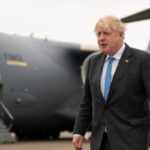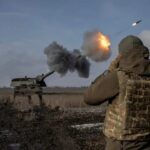By Adam Morrow
The Russian capital remained plagued by aerial drones on the morning of Aug. 1, as military planners in Kyiv appear to have shifted their focus from a ground offensive to the skies over Moscow.
In the early hours of Aug. 1, Moscow’s Moskva-Citi business district was targeted for the second time by aerial drones, Russian authorities said.
According to the Defense Ministry, two incoming drones were neutralized over the city’s Odintsovo and Naro-Fominsk districts without causing damage.
A third drone was jammed by electronic countermeasures, which caused it to crash into the 21st floor of a high-rise building in the business district, the ministry said.
The building reportedly houses offices associated with Russian government ministries, including the ministries of trade, industry, and economic development.
Citing what he described as a “clear and present” danger, Kremlin spokesman Dmitry Peskov told reporters that “measures are being taken.”
On July 29, the same district was rocked by a blast caused by what the Defense Ministry said was a failed Ukrainian drone attack.
Moscow has since described both attacks—neither of which caused deaths or injuries—as “acts of terrorism” by Ukraine.
Russia’s TASS news agency cited a “high-ranking source” in the Air Defense Corps who claimed the drones had originated “from Ukrainian territory.”
Businesses in the affected area have reportedly asked employees to vacate the premises, while others who work in the district are now working remotely.
Increasing Frequency
Ukrainian officials praised the attacks while refraining from taking responsibility for them.
Following the July 29 attack, Ukrainian President Volodymyr Zelenskyy said that Moscow’s invasion of Ukraine was “returning to Russia’s territory—to its symbolic centers.”
And after the Aug. 1 attack, Mykhailo Podolyak, a top adviser to Mr. Zelenskyy, said Moscow was “quickly getting used to full-fledged war.”
He said that Russia should expect “more unidentified drones, more collapse, more civil conflicts, more war.”
The attacks in Moscow weren’t the first of their kind since Russia launched its invasion of Ukraine in early 2022.
On May 2, the Kremlin itself was briefly threatened by two aerial drones. Later in May, three residential buildings in central Moscow were slightly damaged in a similar attack.
On July 24, an aerial drone was downed in the city center not far from a Defense Ministry building. A second drone struck an office building without causing deaths or serious injuries.
The Russian Defense Ministry, for its part, accused Kyiv of attempting to carry out a “terrorist attack” on “facilities in Moscow.”
Mykhailo Fedorov, Ukraine’s deputy prime minister, said at the time that “electronic warfare and air defenses are already less able to defend the skies of the occupiers.”
Following such attacks, Moscow typically claims that all–or most–incoming drones were successfully downed by air defenses or electronic countermeasures.
“No matter what happens,” Mr. Fedorov wrote, “there will be more of this.”
Soon afterward, the State Department reiterated Washington’s position that “we don’t encourage or enable attacks inside Russia.”
When asked about the latest attacks on Moscow’s business district, a State Department spokesperson told The Epoch Times, “As we’ve said before, we have made clear we don’t encourage or enable such attacks.”
Drones over the Black Sea
Recent days have also witnessed a series of drone attacks on Russian targets in the Black Sea and Crimea, the latter of which was effectively annexed by Moscow in 2014.
On Aug. 1, the Russian Defense Ministry claimed that Russian civilian vessels in the Black Sea had come under attack by seaborne drones.
“Last night, the Kyiv regime carried out an attempted terrorist attack with three semi-submersible drones on Russian civilian freight vessels sailing towards the Bosporus Strait,” a ministry spokesman said.
According to the ministry, the drones were destroyed by Russian naval ships deployed near Crimea’s Port of Sevastopol—home to Russia’s Black Sea Fleet—before they could hit their intended targets.
Mr. Podolyak, for his part, described the Russian claims as “fictitious.”
“Ukraine has not attacked, is not attacking, and will not attack civilian vessels, nor any other civilian objects,” he told Reuters.
On July 24, Russian air defenses in Crimea beat back an attack involving 17 aerial drones, according to the Defense Ministry. While no casualties were reported, an ammunition depot was set ablaze in Crimea’s Dzhankoi region.
When asked earlier about Washington’s disapproval of Ukrainian attacks on Russian territory, the State Department spokesman said flatly, “Crimea is part of Ukraine, not Russia.”
The latest attacks in Moscow and Crimea have coincided with intermittent Russian barrages on Ukraine’s Black Sea port of Odesa. The barrages have reportedly left several people dead and critical infrastructure in ruins.
Russian strikes on Odesa began in mid-July after Moscow withdrew from a U.N.-brokered agreement that had let Ukraine export grain through the Black Sea.
According to Moscow, certain parts of the deal—meant to ensure its own agricultural exports—were never honored by Kyiv’s Western allies.
Reuters contributed to this report.






